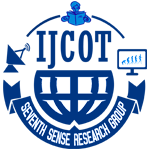Detection Of Brain Tumor Using Kernel Induced Possiblistic C-Means Clustering
 |
International Journal of Computer Organization Trends and Technology (IJCOT) | 
|
| © 2013 by IJCOT Journal | ||
| Volume-3 Issue-5 |
||
| Year of Publication : 2013 | ||
| Authors : D.Napoleon , M.Praneesh |
Citation
D.Napoleon , M.Praneesh . "Detection Of Brain Tumor Using Kernel Induced Possiblistic C-Means Clustering " . International Journal of Computer organization Trends and Technology (IJCOT), V3(5):40-42 Sep - Oct 2013, ISSN 2249-2593, www.ijcotjournal.org. Published by Seventh Sense Research Group.
Abstract
Brain tumor is a major health problem throughout the world. Magnetic resonance imaging (MRI) scan can be used to produce image of any part of the body and it provides an efficient and fast way for diagnosis of the brain tumor. In the Proposed method an efficient detection of brain tumor region from cerebral image is done using Kernel Induced Possiblistic C-means clustering and histogram. The using Kernel Induced Possiblistic C-means clustering algorithm finds the centroids of the cluster groups together the Brain tumor patterns obtained from MRI images. Segmentation result shows the extract tumor region.The performance evaluation of the proposed system is evaluated and compared with existing approaches.
References
[1] C. Busch. Wavelet based texture segmentation of multimodal topographic images. Computer and Graphics, 21(3):347.358, 1997.C.Padraig, and J. D. Sarah, “k-Nearest Neighbor Classifiers”, Technical Report UCD-CSI-2007-4, 2007.
[2] Daniel, C., Mikael, R., and Rachid, D., .A review of statistical approaches to level set segmentation: Integrating color, texture, motion and shape,. International Journal of Computer Vision 72(2), 195.215(2007).
[3] Deorah S, Charles L, Zita A, Timothy R. Trends in brain cancer incidence and survival in the United States: Surveillance, Epidemiology and End results program. Neurosurgery Focus 2006;20:1-7.
[4] G.Mallat ,”theory for multi resolution signal decomposition :The wavelet representation ,”IEEE transaction on pattern analysis and machine intelligence ,vol II .No 711(7):674-693
[5] Guillermo N. Abras and Virginia L. Ballarin,; "A Weighted K-means Algorithm applied to Brain Tissue Classification", JCS&T Vol. 5 No. 3, October 2005.
[6] Hiremath P, Shivashankar S. Wavelet based features for texture classification. Graphics, Vision and Image Processing Journal 2006;6:558.
[7] Huang K, Vicente S. Wavelet feature selection for image classification. IEEE Trans. Image. Proc. 2008; 17:1709-20
[8] Hae Yong Kim “Gradient Histogram-Based Anisotropic Diffusion”, Universidad de Sato Paulo, Escola Politécnica, Dept. Eng. System’s Electronics, Av. Prof. Luciano Gualberto, tr. 3, 158, 05508- 900
[9] R.b Tiwari ,prof,A.R Yardi,”MIETE brain MRI image enhancement based human visual system and local image statistic “,PP100-108,IPCV,2006
[10] S. Wareld, J. Dengler, J. Zaers, C. Guttmann, W. Gil, J. Ettinger, J. Hiller, and R. Kikinis. “Automatic identication of grey matter structures from MRI to improve the segmentation of white matter lesions”. J. of Image Guided Surgery, 1(6):326{338, 1995}.
[11] Z. Wang and D. Hang, “Progressive Switching Median Filter for the Removal of Impulse Noise from Highly Corrupted Images," IEEE Trans. on Circuits and Systems-II: Analog and Digital Signal processing, vol. 46, no. 1, pp. 78-80 Jan. 1999.
[12] Zijdenbos A. and Evans A. 1998.A nonparametric method of automatic correction of intensity of non- uniformity in MRI data.IEEE Trans Medical Image., 17: 8797.
[13] Alirezaie, J., M.E. Jernigan and C. Nahmias, 1997.”Neural Network based segmentation of Magnetic Resonance Images of the Brain”, IEEETrans. Nuclear Science, 44 (2): 194-198.
[14] Chunyan Jiang,Xinhua Zhang,Wanjun Huang,Christoph Meinel.:”Segmentation and Quantification of Brain Tumor,”IEEE International conference on Virtual Environment,Human-Computer interfaces and Measurement Systems, USA, 12-14, July 200.
[15] DeSieno, D., 1988. “Adding a conscience to competitive learning”, Proceeding of IEEE the Second International Conference on Neural networks(ICNN88) 1: 117- 124.
[16] Dunn, J.C., 1973.” A fuzzy relative of the ISODATA process and its use in detecting compact, well Separated clusters”,Journal of Cybernetics, 3: 32-15.
[17] Fu, K.S. and J.K. Mui, 1981.” A survey on image segmentation”, Pattern ecognition, 13: 3-16.
Keywords
Tumor, KPCM Algorithm, Statistical Measures, histogram equalization.

